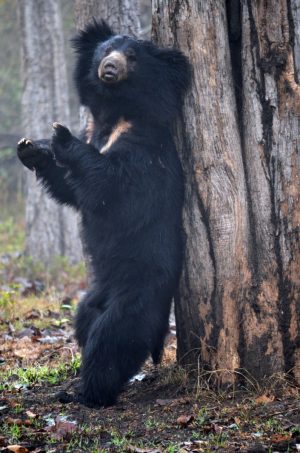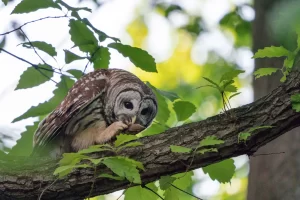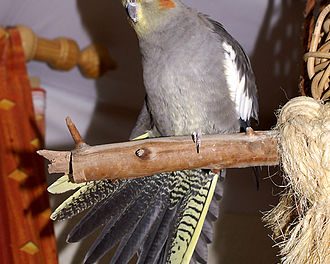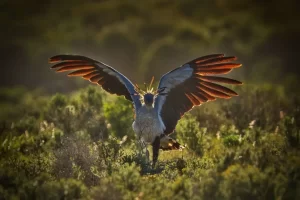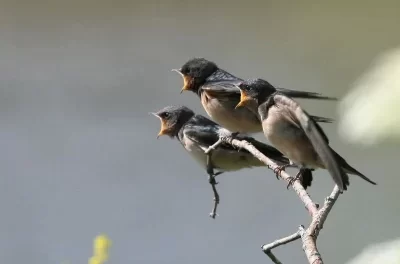The Sloth bear is a myrmecophagous bear species native to the Indian subcontinent. They primarily eat termites and ants and have also been called “labiated bears” because of their long lower lip and palate used for sucking insects. Their long lower lips can be stretched over the outer edge of their noses, and lack upper incisors, thus allowing the bears to suck up large numbers of insects. Sloth bears have long, shaggy fur, a mane around the face, and long, sickle-shaped claws.
Read the full article with PK Halder and get complete knowledge about Sloth Bear.

Sloth bear
Their fur is completely black (rusty for some specimens) with a whitish Y- or V-shaped mark on the chest. The fur does not have an undercoat, thus keeping Sloth bears cool in the tropical climate and protecting them from insects. Females in this species are smaller than males and typically have more fur between their shoulders.
Distribution
Sloth bears are found in India, the southern lowlands of Nepal, and Sri Lanka. They live in a wide range of habitats including wet and dry tropical forests, savannahs, scrublands, and grasslands.

Range of Sloth bears
Description
Sloth bears have shaggy, dusty-black coats; pale, short-haired muzzles; and long, curved claws which they use to excavate termites and ants. A cream-colored “V” or “Y” shape usually marks their chests. Their shaggy fur does not have an undercoat, so it keeps them relatively cool in their native, warm climate and protects them from tropical insects. Sloth bears’ nostrils can close completely, protecting the animals from dust or insects when raiding termite nests or beehives. They have a keen sense of smell, as well as near-sight similar to that of humans.

Sloth bears – description
Adult sloth bears are missing their top two front teeth (incisors), which enables them to suck up termites and other insects with ease. Due to their diet of insects and fruit, their premolars and molars are smaller than those of other bears, but they have large canines to use for defense. It is thought that their feet are turned inward to increase digging efficiency.
The first valid scientific description of this species was by George Shaw in 1791. He called it Ursine bradypus, ursine meaning bearlike and bradypus meaning slow foot. Bradypus is also the genus of three species of sloth. At the time, Shaw thought that the bear was related to a sloth. Time and additional specimens eventually revealed the true taxonomic relationships, but the confusing common name remains.
Habits and Lifestyle

Sloth bear standing – Habits
Sloth bears are generally solitary animals, however, they are sometimes seen in pairs. They are nocturnal, though females become more active in the daytime when with cubs. Sloth bears do not hibernate. They make their day beds out of broken branches in trees and rest in caves during the wet season. Sloth bears walk in slow, shambling motion but are capable of galloping faster than running humans. Although they appear slow and clumsy, Sloth bears are excellent climbers. They may climb to feed and to rest, though not to escape enemies, as they prefer to stand their ground.
Females carry their cubs up trees as the primary defense against attacks by predators instead of sending them up trees. To mark their territories, they scrape trees with their forepaws and rub against them with their flanks. Sloth bears are very vocal and communicate with the help of barks, screams, grunts, roars, snarls, whickers, and woofs. Yelps are made when bears are angered, threatening, or when fighting. When hurt or afraid, they shriek, yowl, or whimper. Sounds such as gurgling or humming are made by bears resting or sucking their paws. Females emit crooning sounds to their cubs.
Diet and Nutrition

Sloth bear cub eating
Sloth bears are omnivorous, mainly myrmecophagous animals. They are expert hunters of termites and ants, which they locate by smell. They also supplement their diet with fruit, honey, and plant matter.
Mating Habits
Little is known about the mating system in Sloth bears. The breeding season varies according to the location: in India, they mate in April, May, and June, and give birth in December and early January, while in Sri Lanka, it occurs all year. Females gestate for 210 days and typically give birth in caves or in shelters under boulders. Litters usually consist of 1 or 2 cubs, or rarely 3. Cubs are born blind and open their eyes after 4 weeks. Sloth bear cubs develop quickly compared to most other bear species: they start walking a month after birth, become independent at 24-36 months, and become

Sloth bears with baby
reproductively mature at the age of 3 years. Young cubs ride on their mother’s back when she walks, runs, or climbs trees until they reach a third of her size. Individual riding positions are maintained by cubs through fighting. Intervals between litters can last 2 to 3 years.
Population
Population threats
Historically, humans have drastically reduced the habitat of Sloth bears and diminished their population by hunting them for food and products such as their bacula and claws. Their habitat was lost due to destruction, fragmentation, over-grazing, extraction of minerals, human settlements, and expansion of agricultural areas, and roads. Sloth bears were also captured and used as performing pets.

Sloth bears
Population number
According to the IUCN Red List, the total population size of Sloth bears is around 20,000 individuals. Currently, this species is classified as Vulnerable (VU) on the IUCN Red List and its numbers today are decreasing.
Ecological niche
Sloth bears play an important part in ecosystems due to their effects on fruits and insects. They help spread the seeds of plants that they eat and they also eat big amounts of termites controlling their population growth.
Fun Facts for Kids
- Sloth bears are the only bears that constantly carry their babies on their backs.
- When feeding, Sloth bears make loud huffing and sucking noises, which can be heard over 100 m away.
- Nostrils of Sloth bears can close completely, thus protecting the animals from dust or insects when they raid termite nests or beehives.
- Sloth bears are good swimmers, and primarily enter the water to play.
- Sloth bears are extremely fond of honey. When feeding their cubs, mothers regurgitate a mixture of half-digested jack fruit, wood apples, and pieces of honeycomb. This sticky substance hardens into a dark yellow, circular, bread-like mass which is fed to the cubs. This “bear’s bread” is considered a delicacy by some of India’s natives.
Reference

